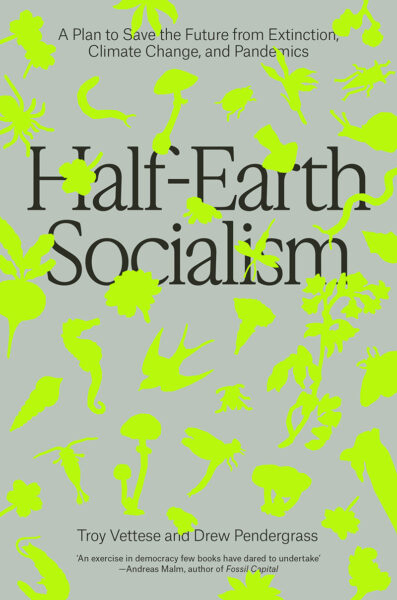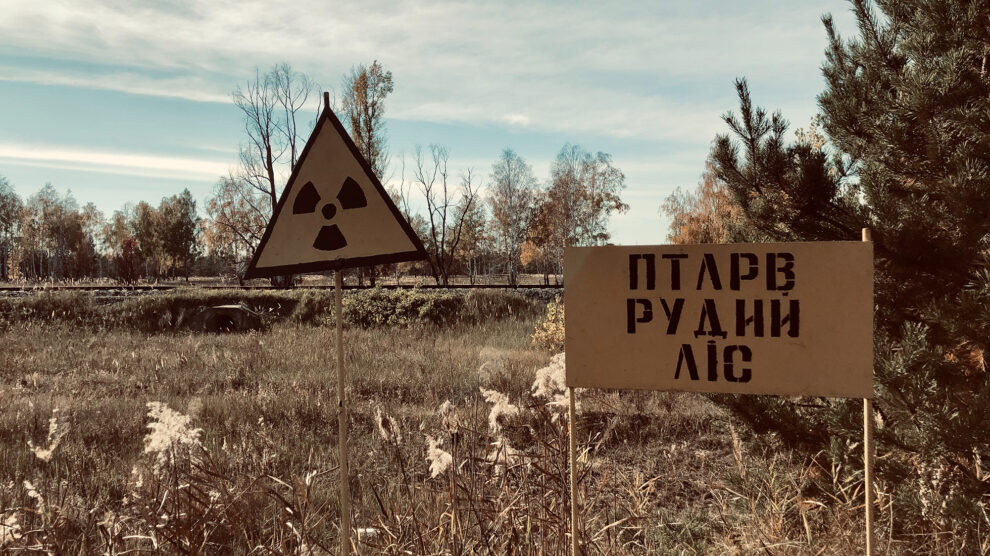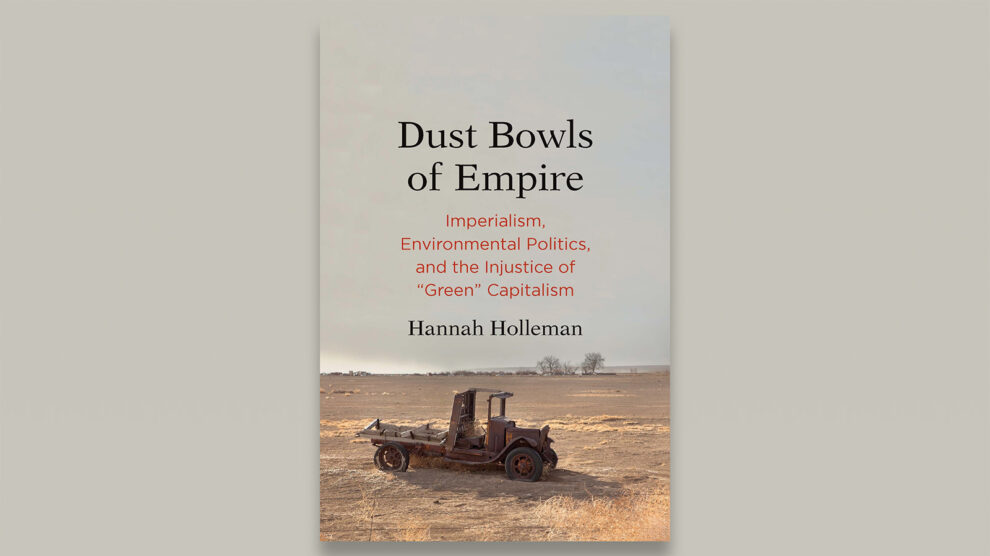How to Build a Utopia
By Nafis Hasan
Volume 25, no. 1, The Soil and the Worker

In one of her final essays, the acclaimed sci-fi writer Ursula K. Le Guin concluded that almost all utopias described in contemporary fiction imagine a world under total control, with little room left for any uncertainty and unknowability. She used the metaphor of yin and yang, where yin portrays uncertainty and yang domination, and speculated whether there was a way to balance each in a utopia. She didn’t have a clear answer but was convinced that thinking along such a line would allow the dreams of endless growth and domination to be replaced by those of adaptability and long-term survival, which involve “a patience with uncertainty and the makeshift, a friendship with water, earth and darkness.”1
It is rather fitting that Half-Earth Socialism, a revival of the utopian socialist tradition by Troy Vettese and Drew Pendergrass, then ends with an aphorism from Le Guin which asks for humility from humans in “dark places.” Humanity is indeed in a dark place with the Sixth Extinction afoot, and increasingly severe disasters with little in the way of relief, either in the form of reducing emissions or preventing biodiversity loss.
Le Guin remains relevant throughout the book, from the authors’ imagined utopia that evokes images of Anarres to the underlying philosophies of the authors. Rejecting both ecomodernism and Malthusianism, both of which assume a total control of nature by humans for their selfish ends, the authors instead advocate for a symbiosis with nature, inspired by Edward Jenner’s contributions to environmental thought. Jenner had posited in 1798 that zoonotic diseases arise when interspecies boundaries are violated (i.e., wild areas being repurposed for human use such as agriculture). Extending that thesis, the authors contend that nature remains unknowable (and ungovernable), and therefore attempts to intervene, through either artificial geoengineering like solar radiation management or neoliberal market mechanisms (e.g. cap-and-trade programs, carbon tax), are doomed to fail. This philosophy serves as the guide for the authors’ fascinating, but critical, thought experiment: What if we could use all the resources available to us to rebuild the world to coexist with nature?
The answer takes the form of “Half-Earth socialism,” a moniker drawn from E. O. Wilson’s controversial Half-Earth proposal, where to save 85 percent of the extant species, we must conserve 50 percent of the land mass. Wilson’s work on island biogeography, which showed that biodiversity depended on the size of the area, led to his realization that nature preserves act as islands. This further informed his callous proposal, which if implemented under capitalism would entrench the displacement of Indigenous people from their lands. Cognizant of such consequences, Vettese and Pendergrass point out that for this proposal to become a reality, it must be socialist in practice. To describe such a socialist system, the authors attempt to answer the “hard questions about politics in an age of ecological collapse: What is socialism? How does socialist democracy work? How could an eco-socialist coalition take power? How would local, national, and global levels of government interact?” (p. 12). Drawing from ecology to cybernetics to history, Vettese and Pendergrass propose a “vision of the future that can develop into a total alternative to capitalism” (p. 21).
Utopia: Socialist and Scientific
At the center of Half-Earth Socialism’s thought experiment is the idea of central planning, i.e., how to best distribute our resources to meet everyone’s needs without involving the market or money. Vettese and Pendergrass draw their inspiration from the Viennese polymath of the early 20th century, Otto Neurath, and use his concept of in natura calculation (calculation in kind) to develop “total plans” for their utopia. While easily confused with a barter system, in natura calculation is defined by the authors as an information system that exposes the relation between different goods. Neurath’s idea of “total plan” is the mobilization of an entire society’s productive capacity—not just labor hours, but other production limits as well, such as natural resources. Such a “total plan,” Neurath imagined, would make money’s function as a universal equivalent irrelevant, thus creating an economy without money. Neurath didn’t leave behind details of how such an information system would work in practice, so the authors turned to the Soviet mathematician Leonid Kantorovich.
Kantorovich’s “linear programming” algorithm, developed in 1939, provided a way to “balance competing restrictions in their natural units—tonnes of steel and concrete or hours of labour” (p. 91). Case in point, during the 1941 siege of Leningrad, Kantorovich was able to use this program to bring thousands of tonnes of supplies (fuel, food, munitions) into the city and transport out approximately one and a half million citizens over the icy Lake Ladoga via trucks in unpredictable winter weather conditions. The algorithm was able to determine, within given constraints, how to best allocate resources for a desired outcome. Kantorovich also used it to optimize factory operations and railroad car production. Such applications showed that resource allocation was possible without the use of money or the invisible hand of the market to balance production and distribution. Despite Kantorovich’s success, however, political reality stood in the way of its full economy-wide application; an ideal centrally planned economy would disempower the Soviet elites, and thus Kantorovich’s algorithm proved to be a thorn in their side.
How would the marriage of Kantorovich’s and Neurath’s ideas work? Vettese and Pendergrass offer a utopian example where a central planning body, Gosplant, creates a number of “total plans” for society based on two major restrictions: (1) how much of nature can be utilized while keeping the biosphere healthy, and (2) how to meet everyone’s needs.2 Current scientific literature on planetary boundaries provides the input on natural resources—e.g., 50 percent of land mass, 62 megatonnes nitrogen, and 6.2 megatonnes phosphate per year that can be used without causing mass eutrophication; 4 petraliters of freshwater for consumption per year; etc. Using these parameters, the Gosplant planners can propose a number of scenarios which have different outcomes (e.g., 30 percent of land mass conserved, or exceeding the carbon budget), each of which, when run through the linear programming algorithm, need to strike a balance between the several different parameters mentioned prior.
These are wishful thinking scenarios, but they are meant to provide the “blueprints” of a society that can survive and thrive within the finite limits of our planet.
Take the case of diet and see the Gosplant plan in action. If the goal is for everyone to eat a healthy diet, then a population (assumed to be ten billion) of majority omnivores would require, under current production regimens, 1.08 hectares of land per capita and 2.05 tonnes of carbon per year. For a world population of majority vegetarians, the cost comes down to 0.14 hectares per person and 1.39 tonnes of carbon per year; and with widespread veganism, land use goes down to 0.13 hectares per person and 1.05 tonnes of carbon per year. A similar plan for energy usage assumes energy quotas for individuals, and strikes a balance between available sources of energy—including fossil fuels, but excluding nuclear power.
Such plans are meant to evolve along with technological developments or social needs. For example, if veganism is not enough to free up land required to save 85 percent of the human species, then the plan could be adjusted to further reduce the energy quota afforded to each person. On the flip side, there could be another plan which doesn’t cut down energy quotas, but rather opts for reducing the number of species that can be saved. A future technological breakthrough—green hydrogen, for instance—could allow planners to meet their ambitious targets (keeping global warming under 1.5°C, total electrification of the energy system, preserving 85 percent of species) and accommodate a population of up to 24 percent omnivores. These are wishful thinking scenarios, but they are meant to provide the “blueprints” of a society that can survive and thrive within the finite limits of our planet. While carrying capacity is often viewed as a de facto Malthusian concept, it is to the authors’ credit that they attempt to propose an all-encompassing socialist alternative that grapples with planetary boundaries that does not rely on ecofascist tropes.
A simple version of the Gosplant would inevitably conjure images of a totalitarian society. The purpose of Gosplant, however, is not to choose which plan should be executed—that is to be decided democratically by a “global parliament” where representatives must decide on trade-offs. To that end, the authors suggest that linear programming be incorporated into public education along with pictographic representation of trade-offs (inspired by Neurath), with the hopes that an education tied to material interests may de-alienate the worker from their labor and help them see themselves as part of a larger whole.
To further remove any suspicions that Gosplant could become Big Brother, the authors propose a multi-layered planning process, where Gosplant would interact with regional governments and workplace managers. Such a “single complex of interconnected models” would operate with autonomy to some degree, and adjust plans according to the feedback to deal with contingencies (p. 119). The flexibility built into the idea of Gosplant also allows it to be applied at different scales—one country, a larger region, or ideally, the whole world—but its function is primarily to process information, rather than to govern.
The authors point to the Cybersyn experiment in Chile, a central planning body developed by cybernetician Stafford Beer for the Salvador Allende government, as a proof-of-concept on how this complex of models might work. When the CIA disrupted communications during the 1973 coup, the Allende government was able to mobilize thousands of workers using this system. Unfortunately, it was ultimately unable to save the Chilean economy against the embargoes put on by the United States. Outside of actually existing socialist states, one would recognize central planning in practice even in the United States, where price controls have historically been used to control the economy.3
Technocratic solutions or blueprints are not uncommon; the Intergovernmental Panel on Climate Change (IPCC) creates various similar models with predicted outcomes and presents them to the UN and national governments. While Gosplant is in part inspired by historical and current climate models, it provides plans for resource allocation and distribution to prevent (or enact) the scenarios that the IPCC reports predict. The fundamental difference remains that Gosplant exists in a world where a socialist revolution has already taken place: rather than asking what is to be done, the authors are asking what to do after. This approach can be seen as avoiding the extremely difficult question of organizing a fragmented working class in an uneven world where imperialism is codified into global supply chains that treat the global South as sacrificial zones. But it also remains true that leftists lack concrete visions of how a socialist society should function, thus necessitating discussions of such futures.
Red Vegans and Green Peasants
The authors’ rejection of artificial geoengineering stems from their embrace of nature as unknowable; they reject nuclear power as a viable option by discounting its advertised benefits. The goals of Half-Earth Socialism then rely on a fully renewable energy system and natural geoengineering, i.e., rewilding, to capture carbon in ecosystems.4 This counterproposal runs into the contentious issue of land scarcity; the authors cite Vaclav Smil’s estimates that a fully renewable energy system will take up to 25–50 percent of landmass in the United States, and almost 100 percent in the United Kingdom. When one adds that 50 percent of landmass needs to be rewilded, it becomes a question of how to thread this extremely fine needle. The authors propose widespread veganism and energy quotas as feasible solutions to this issue.
Any sort of austerity measure has been a source of contention with ecomodernists, whereas veganism as a solution has been attacked by agroecology and peasant movement advocates. In a scathing critique, Max Ajl and Rob Wallace attacked Vettese’s rewilding proposal “for which half of the planet would be scraped clean of humanity” and his veganism for advocating for “brute confiscation and erasure” of peasants and pastoralists.5 The colonial roots of rewilding and conservation adds to the critique, as does the concept of “natural capital,” a way to valorize nature which currently stands at $44 trillion.6
To be clear, Vettese and Pendergrass are well aware of the troubling roots of the half-earth movement and the colonial past of conservation. In fact, they advocate for such rewilding to be managed by Indigenous peoples, although there is little mention of the Land Back movement or reparations/repatriation of stolen land. The utopia depicted at the end of the book does incorporate Indigenous practices such as the Anishinaabe Three Sisters farming (bean, maize, and winter squash) and educational materials from the Axe Handle Academy (part of the Alaska Native Knowledge Network). The utopia also portrays Indigenous folks leading efforts in conservation and governance of their own territories. How these Indigenous territories are re-established, however, remains vague, as does their purpose. For example, do these territories also include land earmarked for rewilding?
Veganism, often a touchy subject for the left, features prominently in the authors’ plans. The authors are well aware that under capitalism, veganism can take the form of privilege and a consumerist solution to the climate crisis. But to them, widespread veganism is the logical outcome of the resource allocation calculations under a socialist regime, considering that livestock comprises 60 percent of total terrestrial biomass, compared to 4 percent wild mammals (the remainder is humans), and takes up four billion hectares (40 percent of habitable land); and 36 percent of calories from the world’s crops are used for animal feed (p. 77).7 To counter the critique of vegan privilege, they point out that in the United States, vegans are disproportionately working-class people of color (wealth is an indicator for meat consumption) and that an average North American eats almost ten times more meat than the average African (p. 105).8 Thus, any restrictions on meat consumption is meant to be disproportionate, with the effect on Western societies preceding those in the global South, whose societies have alternative traditions of farming, sustenance, and relationships with animals. It is also worth noting that the global South suffers directly from this unequal meat consumption. Brazil, for example, is one of the largest meat exporters and is facing increased deforestation at the cost of both biodiversity loss and Indigenous sustenance practices.9
Elsewhere, the authors echo the demand of Degrowth advocates that the global North’s energy use be curbed prior to putting any restrictions on the global South. In fact, Ajl speaks approvingly of energy rations, and supports the idea that democratic participation is necessary to determine use of resources; there is no doubt that both camps support ending10 the cruel practice of factory farming.11
More importantly, it seems that red vegans and green peasants can co-exist within this half-earth utopia. Both sides use Cuba’s Periodo Especial as proof-of-concept of their ideas—a time when Cuba had to decarbonize overnight after being cut off from Soviet oil in the 1990s (p. 83).12 Havana ultimately flourished with twenty-six thousand urban gardens, while almost 30 percent of the land was rewilded. Cubans consumed less meat, and biking and walking replaced cars and buses. Despite such “austerity,” universal healthcare and education were still provided, the shining example of which remains Cuba’s vaccine against COVID-19.13
Besides cursory mention of the need for a coalition of socialists to be led by an anti-nuclear movement, Half-Earth Socialism is sorely missing a concrete organizing strategy, a necessity in today’s world. How do we build the power to implement a utopian plan, or for that matter any plan, when even milquetoast social democratic proposals are being vigorously opposed as emissions rise and IPCC warnings keep ringing? This particular book doesn’t have an answer to that. However, what it does provide is a “starting point for a deeper discussion of how socialism should function in an age of ecological collapse,” a blindspot for those of us who refuse to accept capitalism’s power as inescapable.
Half-Earth Socialism: A Plan to Save the Future from Extinction, Climate Change and Pandemics
Drew Pendergrass and Troy Vettese
Verso
2022
240 pages
Notes
- Electric Literature, “Ursula K. Le Guin Explains How to Build a New Kind of Utopia,” Electric Literature, December 5, 2017, https://electricliterature.com/ursula-k-le-guin-explains-how-to-build-a-new-kind-of-utopia/.
- Gosplant is a play on Gosplan, the Soviet state planning committee.
- Andrew Yamakawa Elrod, “Controlled Prices,” Phenomenal World, January 12, 2022, https://www.phenomenalworld.org/analysis/controlled-prices/; Kate Aronoff, “To Fight Climate Change, Bring Back State Planning,” New York Magazine, January 26, 2022, https://12ft.io/proxy?q=https%3A%2F%2Fnymag.com%2Fintelligencer%2F2022%2F01%2Fto-fight-climate-change-bring-back-state-planning.html.
- Pendergrass and Vettese cite climate scientist Ulrich Kreidenweiss who showed that reforesting 2.6 billion hectares could entomb 860 gigatonnes of CO2 by 2100 (p. 81).
- Max Ajl and Rob Wallace, “Red Vegans against Green Peasants,” New Socialist, October 16, 2021, https://newsocialist.org.uk/red-vegans-against-green-peasants/.
- Alex Heffron and Kai Heron, “Renewing the Land Question: Against Greengrabbing and Green Colonialism,” New Socialist, February 20, 2022, http://newsocialist.org.uk/transmissions/renewing-land-question-against-greengrabbing-and-green-colonialism/.
- Emily S. Cassidy et al., “Redefining Agricultural Yields: from Tonnes to People Nourished per Hectare,” Environmental Research Letters 8, no. 3 (August 2013): 034015, https://iopscience.iop.org/article/10.1088/1748-9326/8/3/034015.
- Jamie Berger, “How Black North Carolinians Pay the Price for the World’s Cheap Bacon,” Vox, April 1, 2022, https://www.vox.com/future-perfect/23003487/north-carolina-hog-pork-bacon-farms-environmental-racism-black-residents-pollution-meat-industry.
- Dom Phillips et al., “Revealed: Rampant Deforestation of Amazon Driven by Global Greed for Meat,” The Guardian, July 2, 2019, https://www.theguardian.com/environment/2019/jul/02/revealed-amazon-deforestation-driven-global-greed-meat-brazil; “Brazil: Amazon Sees Worst Deforestation Levels in 15 Years,” BBC News, November 19, 2021, https://www.bbc.com/news/world-latin-america-59341770#:~:text=Deforestation%20in%20Brazil’s%20Amazon%20rainforest,by%2022%25%20in%20a%20year.
- Publisher’s note: In the print version, the word ‘ending’ was missing.
- Max Ajl, “Beyond the Green New Deal,” Brooklyn Rail, July–August, 2020, https://brooklynrail.org/2020/07/field-notes/Beyond-the-Green-New-Deal-july-aug; Max Ajl “A People’s Green New Deal,” Review of African Political Economy, July 21, 2021, https://roape.net/2021/07/21/a-peoples-green-new-deal-an-interview-with-max-ajl/.
- Aidan Ratchford, “Agroecology and the Survival of Cuban Socialism,” New Socialist, October 16, 2021, http://newsocialist.org.uk/agroecology-and-cuban-socialism/.
- Sam Meredith, “Why Cuba’s Extraordinary Covid Vaccine Success Could Provide the Best Hope for Low-income Countries,” CNBC, January 13, 2022, https://www.cnbc.com/2022/01/13/why-cubas-extraordinary-covid-vaccine-success-could-provide-the-best-hope-for-the-global-south.html.





